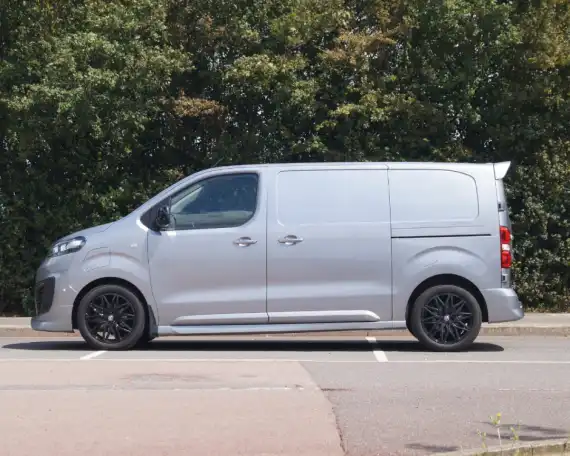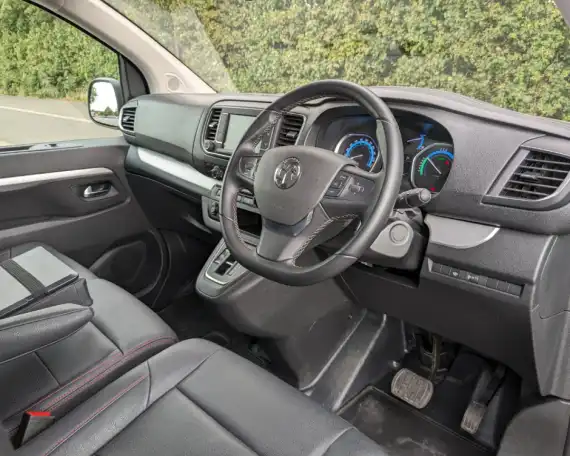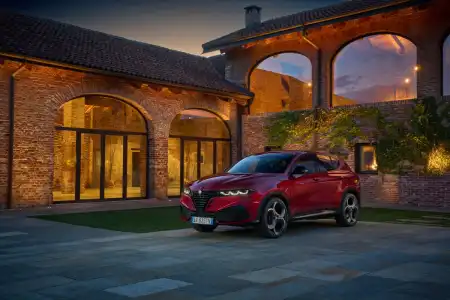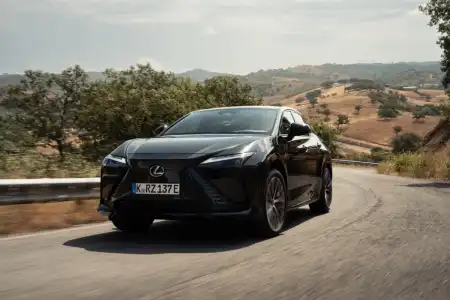- Plusher cabin with swish leather trim
- Stylish and sporty bolt-on bits to the outside
- Impressive cargo volume
- No sportier than a regular Vivaro Electric
- Very expensive to buy
- Small and dated infotainment system
Introduction

One of myriad Stellantis top hats, the Vauxhall Vivaro is the best-selling of the quintet of identical vans — the Citroen e-Dispatch, Fiat e-Scudo, Peugeot e-Expret and Toyota Proace Electric are all essentially the same vehicle — but even then it needs something to differentiate it from its siblings.
The minds at Vauxhall considered a sports version of the Vivaro Electric the way to go, which explains why we’ve got the keys to the Vivaro Electric GS.
Sitting above the Prime and Pro models, the GS gains The GS 18-inch alloy wheels, a lip spoiler at the front, side skirts and a rear roof-mounted spoiler to improve stability when running empty. Inside there are leather coverings on the seats and steering wheel and some GS logos dotted around.
What there isn't is any more power; the sports van upgrades stop at cosmetic touches, but is that enough to make it stand out against a plethora of talented rivals?
Living With The Vauxhall Vivaro Electric GS
There’s no surprise in how the Vivaro Electric GS behaves, as the basic van has been around in one form or another for many years. There’s the same 136hp electric motor we’ve seen in countless vans (and cars) driving the front wheels, powered by a 75kWh battery pack — the GS doesn’t get the option of the cheaper but less useful 50kWh setup.
Power is certainly sufficient, especially when in Sport mode. That unleashes all 136hp which, when empty, gives the van enough performance to be described as peppy, with enough torque to get the front wheels scrabbling for grip from a standstill. It’ll go on to motorway speeds (and then a bit further) without feeling like there’s nothing left in the tank, but that will eat into the van’s range rather rapidly.
Officially, it’ll manage 197 miles on a full charge, and during its time with us, we were getting only a little less than that on average, at 180 miles to a full battery. However, that could drop quickly at motorway speeds, especially when loaded. Stick to ‘normal’ driving mode, and you won’t get all the power, but will save some battery. The ‘eco’ mode cuts things back to a miserable degree, and you’ll soon switch it off.
The upgraded cabin is slightly nicer than the regular Vivaro, with leather seats and a nice leather-covered steering wheel, but it still feels a little last-generation. There’s not too much that’s inherently wrong, but the dated 7.0-inch infotainment screen (with Android Auto and Apple CarPlay, happily) can’t be masked by red stitching, and GS logos embossed into the seats.
The passenger bench offers plenty of space, even when the van is three-up, but it’s definitely better suited to being used by just a driver and their mate as the centre passenger gets a raw deal. That’s true of every van on the market, though. What’s unique to the Vauxhall and its Stellantis siblings is the offset driving position that will frustrate — the steering wheel is left of centre, with the pedals right of centre — and will be noticed by those using their van for more than short journeys.

Space & Practicality
Vauxhall has reduced the number of boy options for the GS version of the Vivaro Electric, so you get the low roof height and the short wheelbase. That’s probably to do with driving dynamics, as this is meant to be the sporty and agile version of the van.
Even then, you’ll be able to squeeze a load of up to 2,512mm long and 1,636mm wide in the back, with a roof height of 1,397mm. That gives a cargo volume of 5.3m3, which is on par with its rivals. The low height might limit load volumes a little, but it also means the Vivaro will happily fit into most multi-storey car parks or other low-roof locations without issue.
Those wanting something more capacious will need to look elsewhere unless the clever load-through option works for you. This provides a small opening in the full metal bulkhead to slide lone, thin objects through, rendering the passenger seat unusable but extending load lengths to 3,674mm.
The cargo area is accessed by a sliding door on both sides of the vam, with barn-style rear doors that swing open to 180 degrees, giving easy access for a forklift; even between the wheel arches, the Vivaro will happily take a couple of Euro pallets.
Payload limits are fine for an electric van, with the GS model able to take up to 1,000kg in the back, with a towing limit of one tonne.
Ownership

Running Costs
For most, the decision to switch to electric power is purely financial, and the savings you can make on day-to-day running might move the needle in the Vivaro Electric GSs direction.
The 197-mile range is likely to be more than enough for most users, even when cold and fully loaded — we ran the van with half a tonne in the back and still returned reasonably good economy. That means recharging can likely be done at a work depot or home overnight, bringing costs right down to around £25 for a full charge, and even less if you can get onto a specific electric vehicle tariff. That’s cheaper than diesel — you’d have to average more than 50mpg to balance the fuel costs.
Add on savings from avoiding paying for ULEZ and congestion charges, which are expanding across the country, and your daily costs could plummet. Less frequent servicing and lower service costs will also keep expenditures in check.
Of course, you need to balance that with the £57,800 asking price before VAT and any plug-in van grants, which makes it considerably more expensive — £14,800 more expensive, to be exact — than the diesel-powered GS model.
Verdict

I stepped into the Vivaro Electric GS with low expectations. The van, this time wearing a Vauxhall badge, is familiar and falls a little short of some of its rivals, and slapping a GS badge on felt a touch desperate, especially when there have been no mechanical upgrades.
But something about the GS appealed, and I enjoyed the van more than I expected. On paper, there’s simply no reason to opt for this over a Vivaro Pro van, but for owner-operators and small businesses, the extra style and slightly more premium cabin will make it easy to live with. It’ll become more than simply a works vehicle.
It still boasts a class-leading cargo volume and competitive payload capacity, which helps make a case for the GS. But, as ever with one of these Stellantis-built models, you have to wonder if a Citroen, Fiat, Peugeot or Toyota would be a better bet.
Not if you want some sporting style — the Vauxhall is the only one to have the cosmetic updates and the only one to look at least a little more appealing amongst a row of identikit models.
It’s a heart or head decision; the sporty GS or the sensible Pro. Neither is a poor choice.



